High-Resolution WRF Modeling of Wind and Thermal Regimes with LCZ in Almaty, Kazakhstan
Abstract
:1. Introduction
2. Materials and Methods
2.1. Description of the Object under Study
2.2. Land Use/Land Cover
2.3. WRF Model Domain
2.4. Model Configuration and Simulations
2.5. Methodology for Comparing Simulations with Observations
3. Results and Discussion: Thermal and Wind Regime
3.1. Comparative Analysis for Various Land Use Maps
3.2. Comparison of Wind Regime with Remote Sensing Data
3.3. Comparison of High-Resolution Data with Meteorological Observation Data
3.4. Comparison of Temperature Regime with Remote Sensing Data
3.5. Comparison with Radiosounde Data
3.6. Turbulence
4. Discussion
5. Conclusions
Author Contributions
Funding
Institutional Review Board Statement
Informed Consent Statement
Data Availability Statement
Acknowledgments
Conflicts of Interest
References
- Skamarock, W.C.; Klemp, J.B.; Dudhia, J.B.; Gill, D.O.; Barker, D.M.; Duda, M.G.; Huang, X.-Y.; Wang, W.; Powers, J.G. A Description of the Advanced Research WRF Model Version 4.3 (No. NCAR/TN-556+STR). NCAR Tech. Note 2021. [Google Scholar] [CrossRef]
- Zakarin, E.A.; Baklanov, A.A.; Balakay, L.A.; Dedova, T.V.; Bostanbekov, K.A. Simulation of Air Pollution in Almaty City under Adverse Weather Conditions. Russ. Meteorol. Hydrol. 2021, 46, 121–128. [Google Scholar] [CrossRef]
- Zakarin, E.; Baklanov, A.; Balakay, L.; Dedova, T.; Bostanbekov, K. Modeling of the Calm Situations in the Atmosphere of Almaty. Asian J. Atmos. Environ. 2022, 16, 14–31. [Google Scholar] [CrossRef]
- Berardi, U.; Jandaghian, Z.; Graham, J. Effects of Greenery Enhancements for the Resilience to Heat Waves: A Comparison of Analysis Performed through Mesoscale (WRF) and Microscale (Envi-Met) Modeling. Sci. Total Environ. 2020, 747, 141300. [Google Scholar] [CrossRef]
- Wong, N.H.; He, Y.; Nguyen, N.S.; Raghavan, S.V.; Martin, M.; Hii, D.J.C.; Yu, Z.; Deng, J. An Integrated Multiscale Urban Microclimate Model for the Urban Thermal Environment. Urban Clim. 2021, 35, 100730. [Google Scholar] [CrossRef]
- Bauer, H.S.; Muppa, S.K.; Wulfmeyer, V.; Behrendt, A.; Warrach-Sagi, K.; Späth, F. Multi-Nested WRF Simulations for Studying Planetary Boundary Layer Processes on the Turbulence-Permitting Scale in a Realistic Mesoscale Environment. Tellus Ser. A Dyn. Meteorol. Oceanogr. 2020, 72, 1–28. [Google Scholar] [CrossRef]
- Zhu, D.; Zhou, X.; Cheng, W. Water Effects on Urban Heat Islands in Summer Using WRF-UCM with Gridded Urban Canopy Parameters—A Case Study of Wuhan. Build. Environ. 2022, 225, 109528. [Google Scholar] [CrossRef]
- Moya-Álvarez, A.S.; Martínez-Castro, D.; Kumar, S.; Estevan, R.; Silva, Y. Response of the WRF Model to Different Resolutions in the Rainfall Forecast over the Complex Peruvian Orography. Theor. Appl. Clim. 2019, 137, 2993–3007. [Google Scholar] [CrossRef]
- Hope, A.P.; Lopez-Coto, I.; Hajny, K.; Tomlin, J.M.; Kaeser, R.; Stirm, B.; Karion, A.; Shepson, P.B. Analyzing “Gray Zone” Turbulent Kinetic Energy Predictions in the Boundary Layer from Three WRF PBL Schemes over New York City and Comparison with Aircraft Measurements. J. Appl. Meteorol. Clim. 2024, 63, 125–142. [Google Scholar] [CrossRef]
- Bougeault, P.; Lacarrere, P. Parameterization of Orography-Induced Turbulence in a Mesobeta-Scale Model. Mon. Weather Rev. 1989, 117, 1039–1057. [Google Scholar] [CrossRef]
- Martilli, A.; Clappier, A.; Rotach, M.W. An Urban Surface Exchange Parameterisation for Mesoscale Models. Bound. Layer Meteorol. 2002, 104, 261–304. [Google Scholar] [CrossRef]
- Martilli, A.; Clarke, S.G.; Tewari, M.; Manning, K.W. Description of the Modification s Made in WRF.3.1 and Short User’s Manual of BEP; National Center for Atmospheric Research: Boulder, CO, USA, 2009. [Google Scholar]
- Siewert, J.; Kroszczynski, K. Evaluation of High-Resolution Land Cover Geographical Data for the WRF Model Simulations. Remote Sens. 2023, 15, 2389. [Google Scholar] [CrossRef]
- Golzio, A.; Ferrarese, S.; Cassardo, C.; Diolaiuti, G.A.; Pelfini, M. Land-Use Improvements in the Weather Research and Forecasting Model over Complex Mountainous Terrain and Comparison of Different Grid Sizes. Bound. Layer Meteorol. 2021, 180, 319–351. [Google Scholar] [CrossRef]
- Stewart, I.D.; Oke, T.R. Local Climate Zones for Urban Temperature Studies. Bull. Am. Meteorol. Soc. 2012, 93, 1879–1900. [Google Scholar] [CrossRef]
- WUDAPT. World Urban Database and Access Portal Tools. Available online: http://www.wudapt.org/ (accessed on 15 June 2024).
- Lehnert, M.; Savić, S.; Milošević, D.; Dunjić, J.; Geletič, J. Mapping Local Climate Zones and Their Applications in European Urban Environments: A Systematic Literature Review and Future Development Trends. ISPRS Int. J. Geoinf. 2021, 10, 260. [Google Scholar] [CrossRef]
- Vuckovic, M.; Hammerberg, K.; Mahdavi, A. Urban Weather Modeling Applications: A Vienna Case Study. Build. Simul. 2020, 13, 99–111. [Google Scholar] [CrossRef]
- Brousse, O.; Martilli, A.; Foley, M.; Mills, G.; Bechtel, B. WUDAPT, an Efficient Land Use Producing Data Tool for Mesoscale Models? Integration of Urban LCZ in WRF over Madrid. Urban Clim. 2016, 17, 116–134. [Google Scholar] [CrossRef]
- Zonato, A.; Martilli, A.; Di Sabatino, S.; Zardi, D.; Giovannini, L. Evaluating the Performance of a Novel WUDAPT Averaging Technique to Define Urban Morphology with Mesoscale Models. Urban Clim. 2020, 31, 100584. [Google Scholar] [CrossRef]
- Molnár, G.; Gyöngyösi, A.Z.; Gál, T. Integration of an LCZ-Based Classification into WRF to Assess the Intra-Urban Temperature Pattern under a Heatwave Period in Szeged, Hungary. Theor. Appl. Clim. 2019, 138, 1139–1158. [Google Scholar] [CrossRef]
- Mu, Q.; Miao, S.; Wang, Y.; Li, Y.; He, X.; Yan, C. Evaluation of Employing Local Climate Zone Classification for Mesoscale Modelling over Beijing Metropolitan Area. Meteorol. Atmos. Phys. 2020, 132, 315–326. [Google Scholar] [CrossRef]
- McRae, I.; Freedman, F.; Rivera, A.; Li, X.; Dou, J.; Cruz, I.; Ren, C.; Dronova, I.; Fraker, H.; Bornstein, R. Integration of the WUDAPT, WRF, and ENVI-Met Models to Simulate Extreme Daytime Temperature Mitigation Strategies in San Jose, California. Build. Environ. 2020, 184, 107180. [Google Scholar] [CrossRef]
- Richard, Y.; Emery, J.; Dudek, J.; Pergaud, J.; Chateau-Smith, C.; Zito, S.; Rega, M.; Vairet, T.; Castel, T.; Thévenin, T.; et al. How Relevant Are Local Climate Zones and Urban Climate Zones for Urban Climate Research? Dijon (France) as a Case Study. Urban Clim. 2018, 26, 258–274. [Google Scholar] [CrossRef]
- Du, R.; Liu, C.H.; Li, X.X.; Lin, C.Y. Effect of Local Climate Zone (LCZ) and Building Category (BC) Classification on the Simulation of Urban Climate and Air-Conditioning Load in Hong Kong. Energy 2023, 271, 127004. [Google Scholar] [CrossRef]
- Patel, P.; Karmakar, S.; Ghosh, S.; Niyogi, D. Improved Simulation of Very Heavy Rainfall Events by Incorporating WUDAPT Urban Land Use/Land Cover in WRF. Urban Clim. 2020, 32, 100616. [Google Scholar] [CrossRef]
- System for Integrated ModelLling of Atmospheric CoMposition. Available online: https://silam.fmi.fi/ (accessed on 15 June 2024).
- USGS EROS Archive-Landsat Archives-Landsat 8-9 Operational Land Imager and Thermal Infrared Sensor Collection 2 Level-1 Data. Available online: https://www.usgs.gov/centers/eros/science/usgs-eros-archive-landsat-archives-landsat-8-9-operational-land-imager-and (accessed on 10 April 2024).
- Statistics of the Regions of the Republic of Kazakhstan. Almaty City. Available online: https://stat.gov.kz/en/region/almaty/ (accessed on 15 June 2024).
- Vilesov, E.N. Climatic Conditions of Almaty; Al-Farabi Kazakh National University Press: Almaty, Kazakhstan, 2010. [Google Scholar]
- Akhmetzhanov, H.A.; Shver, I.A. (Eds.) The Climate of Alma-Ata; Hydrometizdat: Leningrad, Russia, 1985. [Google Scholar]
- Demuzere, M.; Kittner, J.; Bechtel, B. LCZ Generator: A Web Application to Create Local Climate Zone Maps. Front. Environ. Sci. 2021, 9, 637455. [Google Scholar] [CrossRef]
- Fast and Easy Local Climate Zone Mapping. Available online: https://lcz-generator.rub.de/ (accessed on 15 June 2024).
- Global Data Explorer (GDEx). Available online: https://lpdaac.usgs.gov/news/global-data-explorer-gdex-has-been-retired/ (accessed on 10 April 2024).
- Global Forecast System (GFS). Available online: https://www.ncei.noaa.gov/products/weather-climate-models/global-forecast (accessed on 10 April 2024).
- Jiménez, P.A.; Dudhia, J. On the Ability of the WRF Model to Reproduce the Surface Wind Direction over Complex Terrain. J. Appl. Meteorol. Climatol. 2013, 52, 1610–1617. [Google Scholar] [CrossRef]
- Michelson, S.A.; Bao, J.W. Sensitivity of Low-Level Winds Simulated by the WRF Model in California’s Central Valley to Uncertainties in the Large-Scale Forcing and Soil Initialization. J. Appl. Meteorol. Clim. 2008, 47, 3131–3149. [Google Scholar] [CrossRef]
- Bao, J.-W.; Michelson, S.A.; Persson, P.O.G.; Djalalova, I.V.; Wilczak, J.M. Observed and WRF-Simulated Low-Level Winds in a High-Ozone Episode during the Central California Ozone Study. J. Appl. Meteorol. Clim. 2008, 47, 2372–2394. [Google Scholar] [CrossRef]
- Isaev, E.K.; Mostamandi, S.V.; Aniskina, O.G. Evaluation of the Influence of the Parameterization of Physical Processes in the WRF Hydrodynamic Model on the Quality of the Forecast of Atmospheric Processes in an Area with a Complex Topography Using the Example of the Territory of Kyrgyzstan. Uchenye Zap. RGGMU 2015, 30–41. [Google Scholar]
- Lim, J.O.J.; Hong, S.Y.; Dudhia, J. The WRF-Single-Moment-Microphysics Scheme and Its Evaluation of the Simulation of Mesoscale Convective Systems. Bull. Am. Meteorol. Soc. 2004. [Google Scholar]
- Kain, J.S.; Kain, J. The Kain-Fritsch Convective Parameterization: An Update. J. Appl. Meteorol. 2004, 43, 170–181. [Google Scholar] [CrossRef]
- Iacono, M.J.; Delamere, J.S.; Mlawer, E.J.; Shephard, M.W.; Clough, S.A.; Collins, W.D. Radiative Forcing by Long-Lived Greenhouse Gases: Calculations with the AER Radiative Transfer Models. J. Geophys. Res. Atmos. 2008, 113, D13103. [Google Scholar] [CrossRef]
- Monin, A.S.; Obukhov, A.M. Basic Laws of Turbulent Mixing in the Surface Layer of the Atmosphere. Contrib. Geophys. Inst. Acad. Sci. USSR 1954, 151, e187. [Google Scholar]
- Ek, M.B.; Mitchell, K.E.; Lin, Y.; Rogers, E.; Grunmann, P.; Koren, V.; Gayno, G.; Tarpley, J.D. Implementation of Noah Land Surface Model Advances in the National Centers for Environmental Prediction Operational Mesoscale Eta Model. J. Geophys. Res. Atmos. 2003, 108. [Google Scholar] [CrossRef]
- Weather for 241 Countries of the World. Available online: https://rp5.kz/Weather_in_the_world (accessed on 15 June 2024).
- Wilks, D.S. Time Series. In International Geophysics; Academic Press: Cambridge, MA, USA, 2011; pp. 395–456. [Google Scholar]
- Wang, D.; Liu, Y.; Yu, T.; Zhang, Y.; Liu, Q.; Chen, X.; Zhan, Y. A Method of Using WRF-Simulated Surface Temperature to Estimate Daily Evapotranspiration. J. Appl. Meteorol. Clim. 2020, 59, 901–914. [Google Scholar] [CrossRef]
- Azargoshasbi, F.; Ashrafi, K.; Ehsani, A.H. Role of Urban Boundary Layer Dynamics and Ventilation Efficiency in a Severe Air Pollution Episode in Tehran, Iran. Meteorol. Atmos. Phys. 2023, 135, 35. [Google Scholar] [CrossRef]
- Fu, P.; Weng, Q. Responses of Urban Heat Island in Atlanta to Different Land-Use Scenarios. Theor. Appl. Clim. 2018, 133, 123–135. [Google Scholar] [CrossRef]
- Kaasik, M.; Prank, M.; Sofiev, M. Running the SILAM Model Comparatively with ECMWF and HIRLAM Meteorological Fields: A Case Study in Lapland. In Integrated Systems of Meso-Meteorological and Chemical Transport Models; Springer: Berlin/Heidelberg, Germany, 2011. [Google Scholar]
- Prank, M.; Sofiev, M.; Kaasik, M.; Ruuskanen, T.; Kukkonen, J.; Kulmala, M. The Origins and Formation Mechanisms of Aerosol during a Measurement Campaign in Finnish Lapland, Evaluated Using the Regional Dispersion Model SILAM. In Air Pollution Modeling and Its Application XIX; NATO Science for Peace and Security Series C: Environmental Security; Springer: Cham, Switzerland, 2008. [Google Scholar]
- Sofiev, M.; Siljamo, P.; Valkama, I.; Ilvonen, M.; Kukkonen, J. A Dispersion Modelling System SILAM and Its Evaluation against ETEX Data. Atmos. Environ. 2006, 40, 674–685. [Google Scholar] [CrossRef]
- ECOSERVICE-S LLP. Available online: https://ecoservice.kz/ (accessed on 15 June 2024).
- University of Wyoming Databases. Available online: http://weather.uwyo.edu/upperair/sounding.html (accessed on 10 April 2024).
- Welch, P.D. The Use of Fast Fourier Transform for the Estimation of Power Spectra: A Method Based on Time Averaging Over Short, Modified Periodograms. IEEE Trans. Audio Electroacoust. 1967, 15, 70–73. [Google Scholar] [CrossRef]
- Temirbekov, N.; Kasenov, S.; Berkinbayev, G.; Temirbekov, A.; Tamabay, D.; Temirbekova, M. Analysis of Data on Air Pollutants in the City by Machine-Intelligent Methods Considering Climatic and Geographical Features. Atmosphere 2023, 14, 892. [Google Scholar] [CrossRef]
- Di Bernardino, A.; Mazzarella, V.; Pecci, M.; Casasanta, G.; Cacciani, M.; Ferretti, R. Interaction of the Sea Breeze with the Urban Area of Rome: WRF Mesoscale and WRF Large-Eddy Simulations Compared to Ground-Based Observations. Bound. Layer Meteorol. 2022, 185, 333–363. [Google Scholar] [CrossRef]
- Helmholtz, N.F. Mountain-Valley Circulation of the Tien Shan Northern Slopes; Hydrometizdat: Leningrad, Russia, 1963. [Google Scholar]
- Dedova, T.; Balakay, L.; Zakarin, E.; Bostanbekov, K.; Abdimanap, G. Investigating Stagnant Air Conditions in Almaty: A WRF Modeling Approach. Atmosphere 2024, 15, 633. [Google Scholar] [CrossRef]
- Icon Model. Available online: https://www.icon-model.org/icon_model (accessed on 7 August 2024).

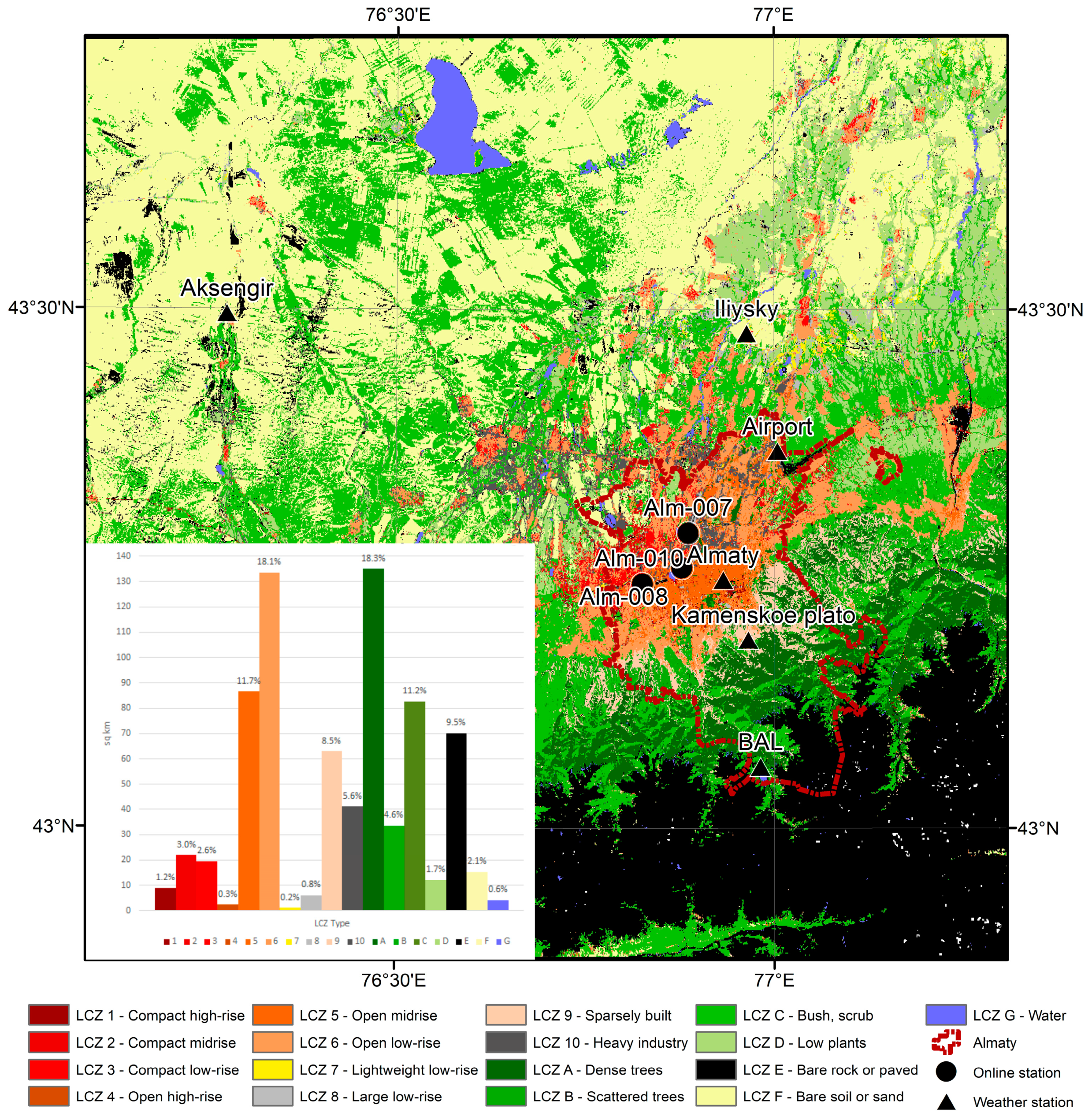
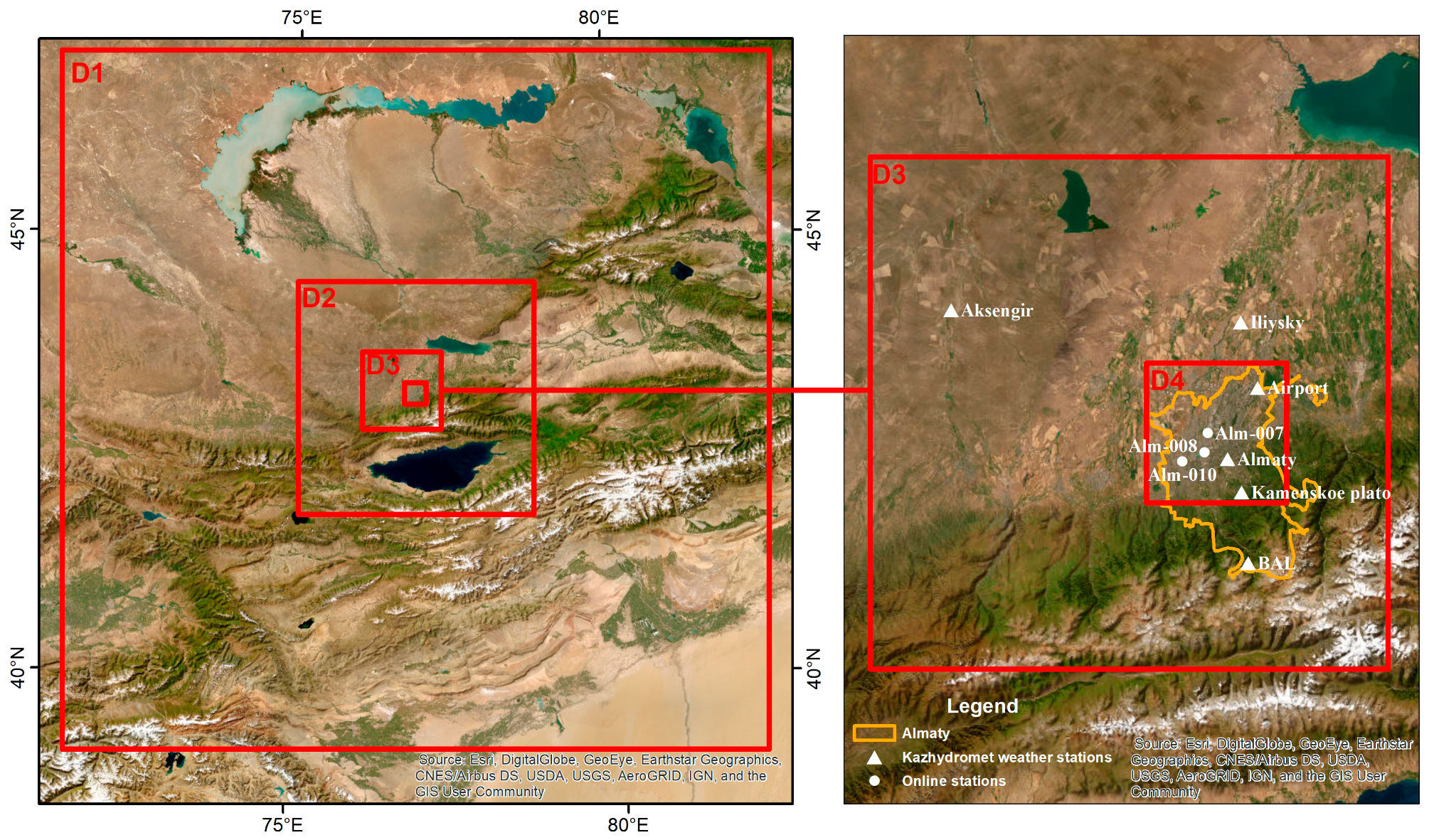
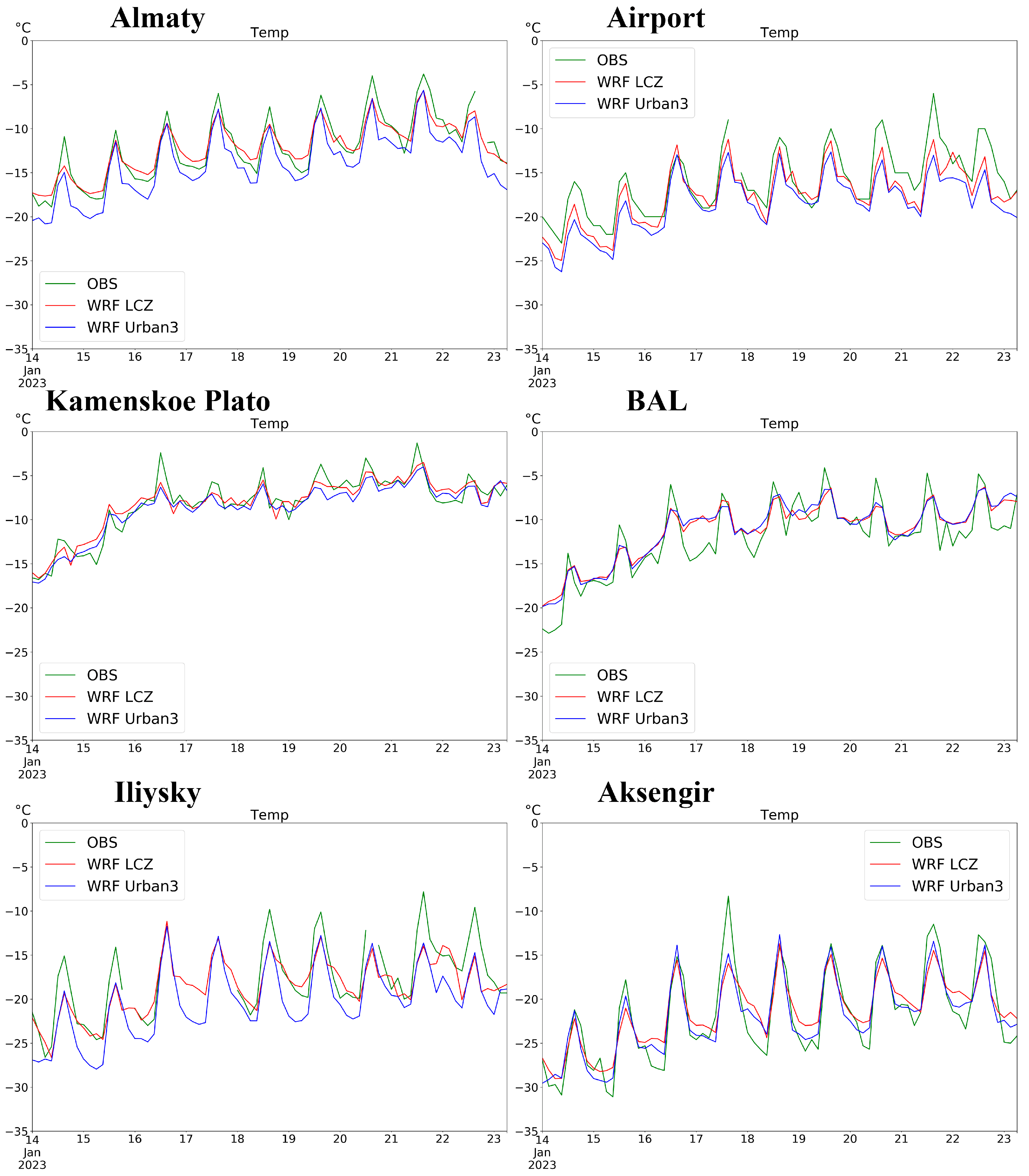

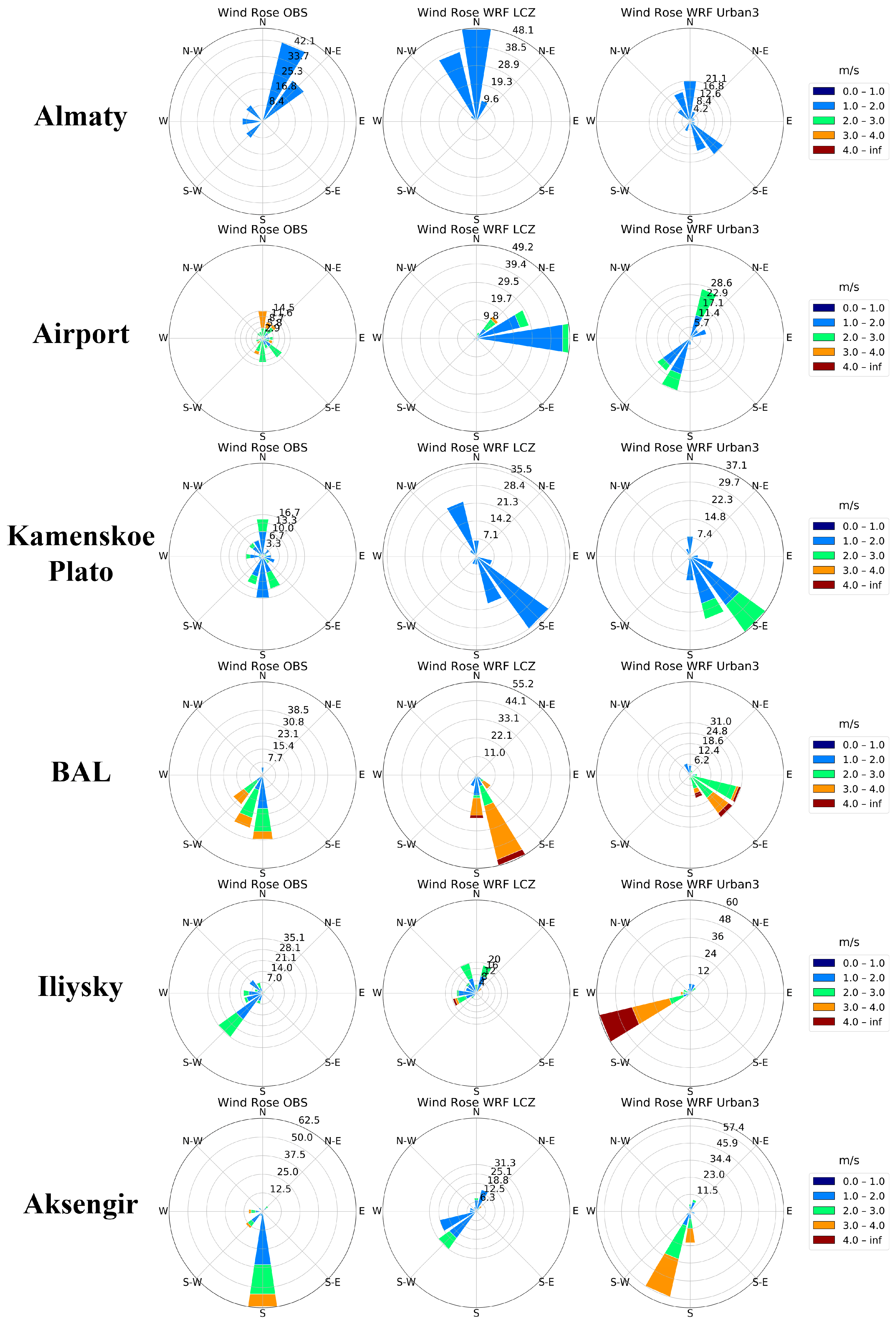
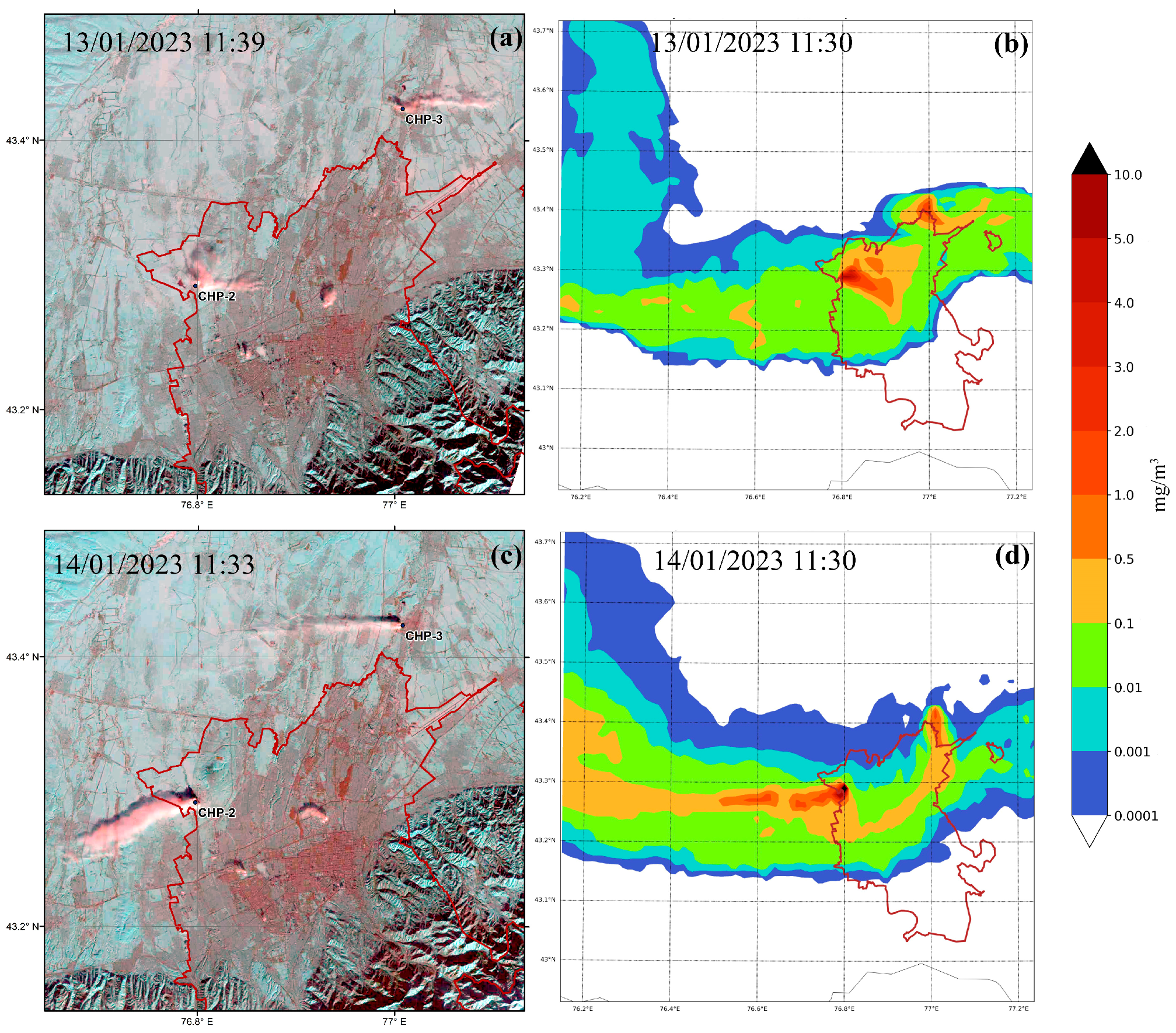
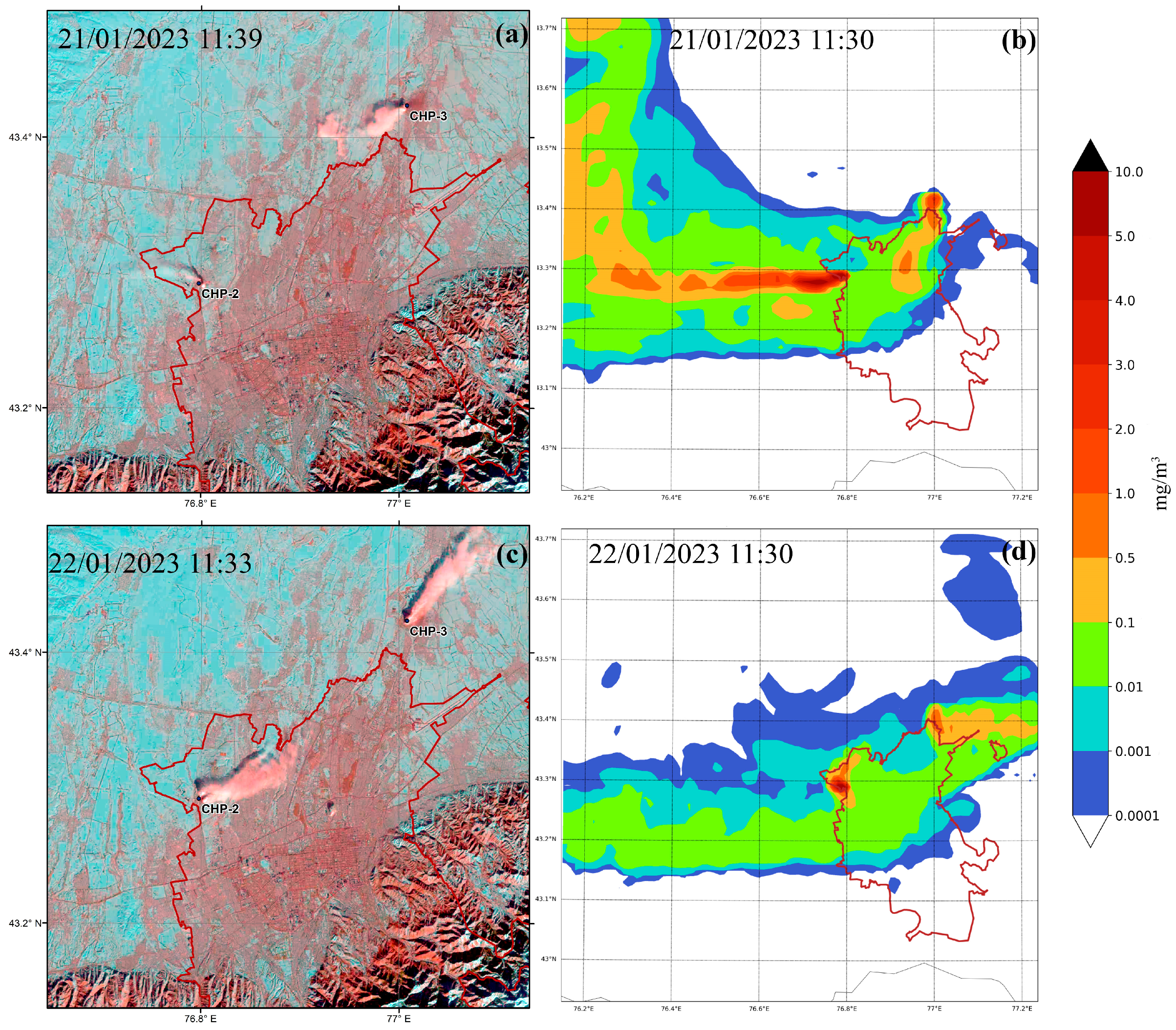
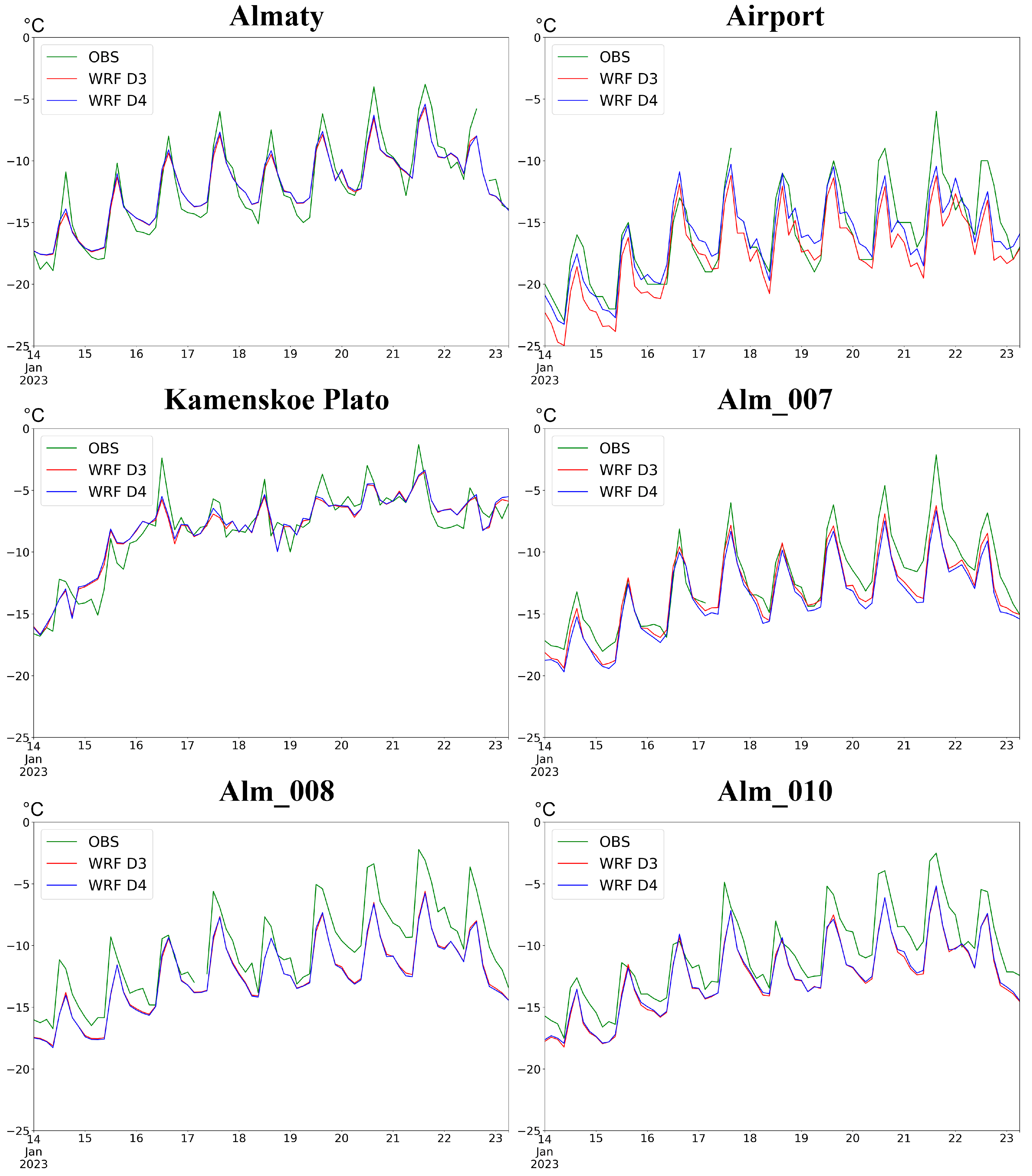

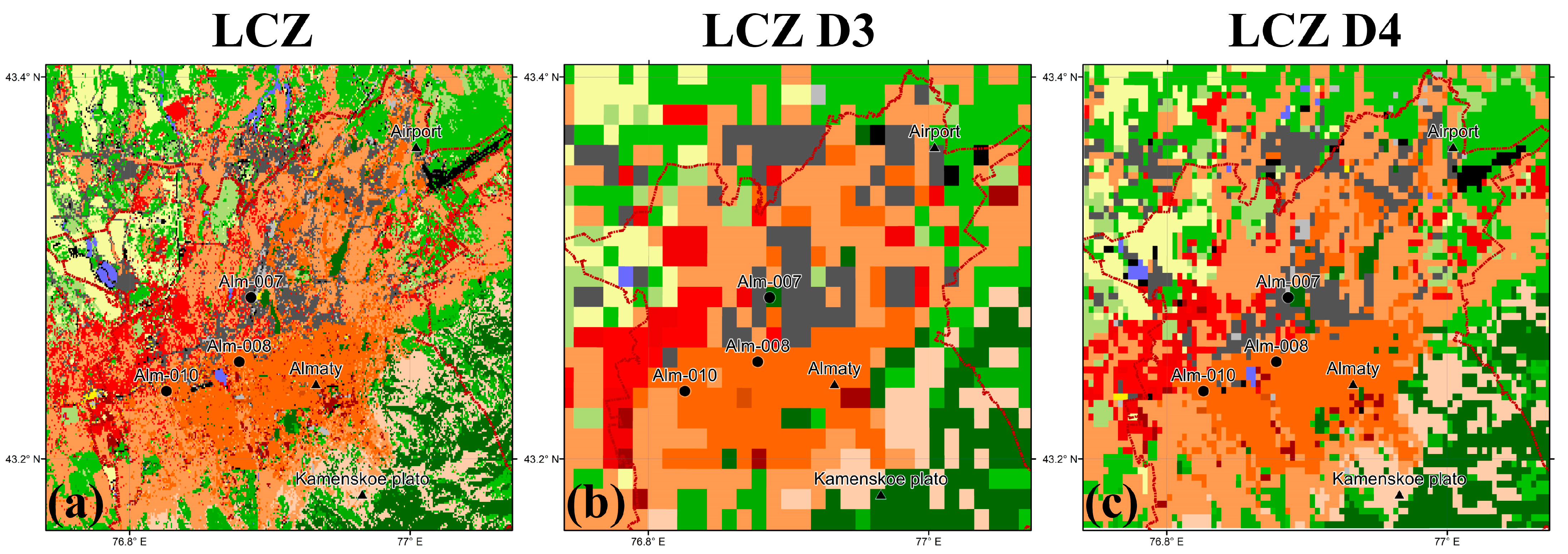

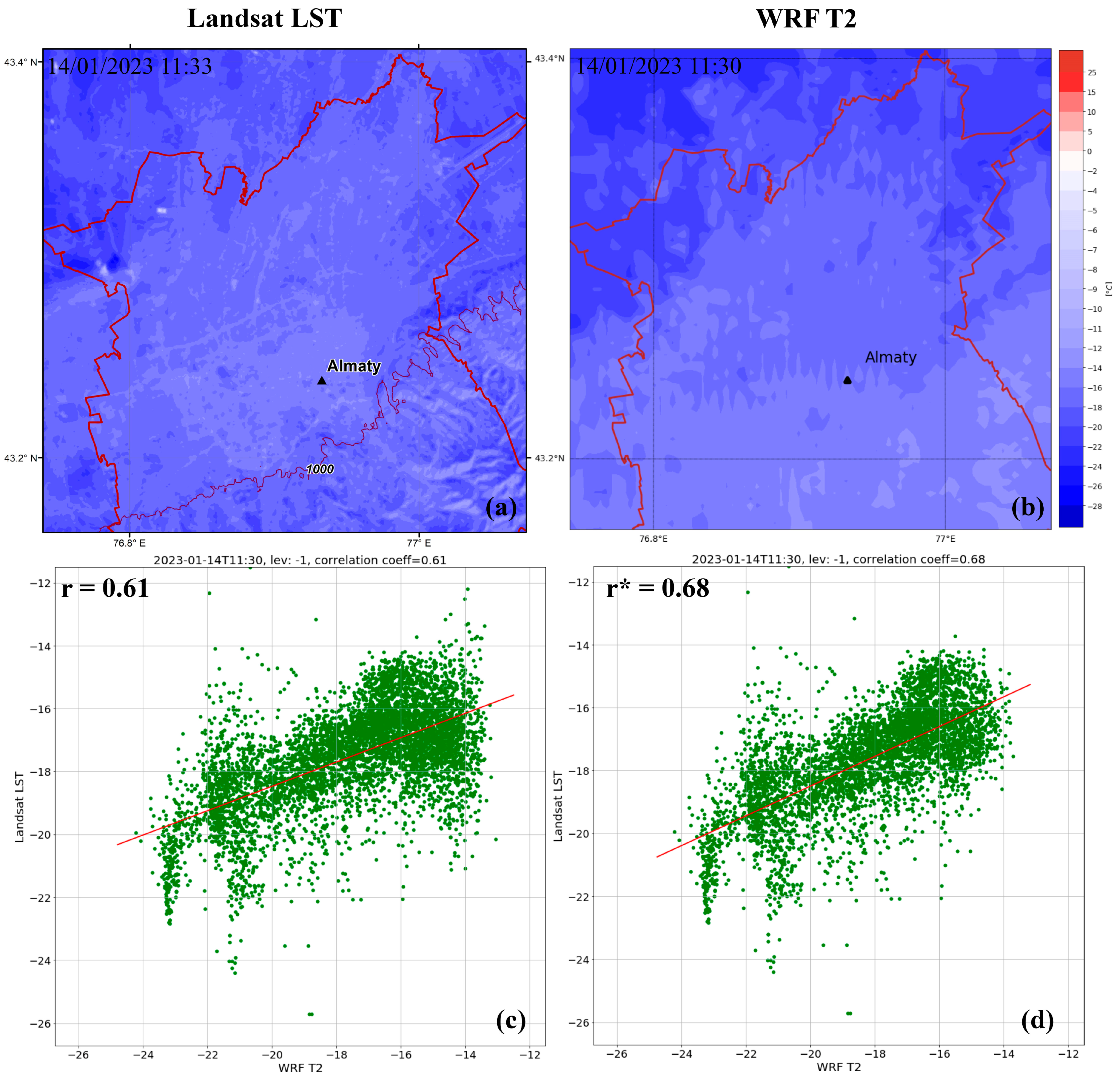

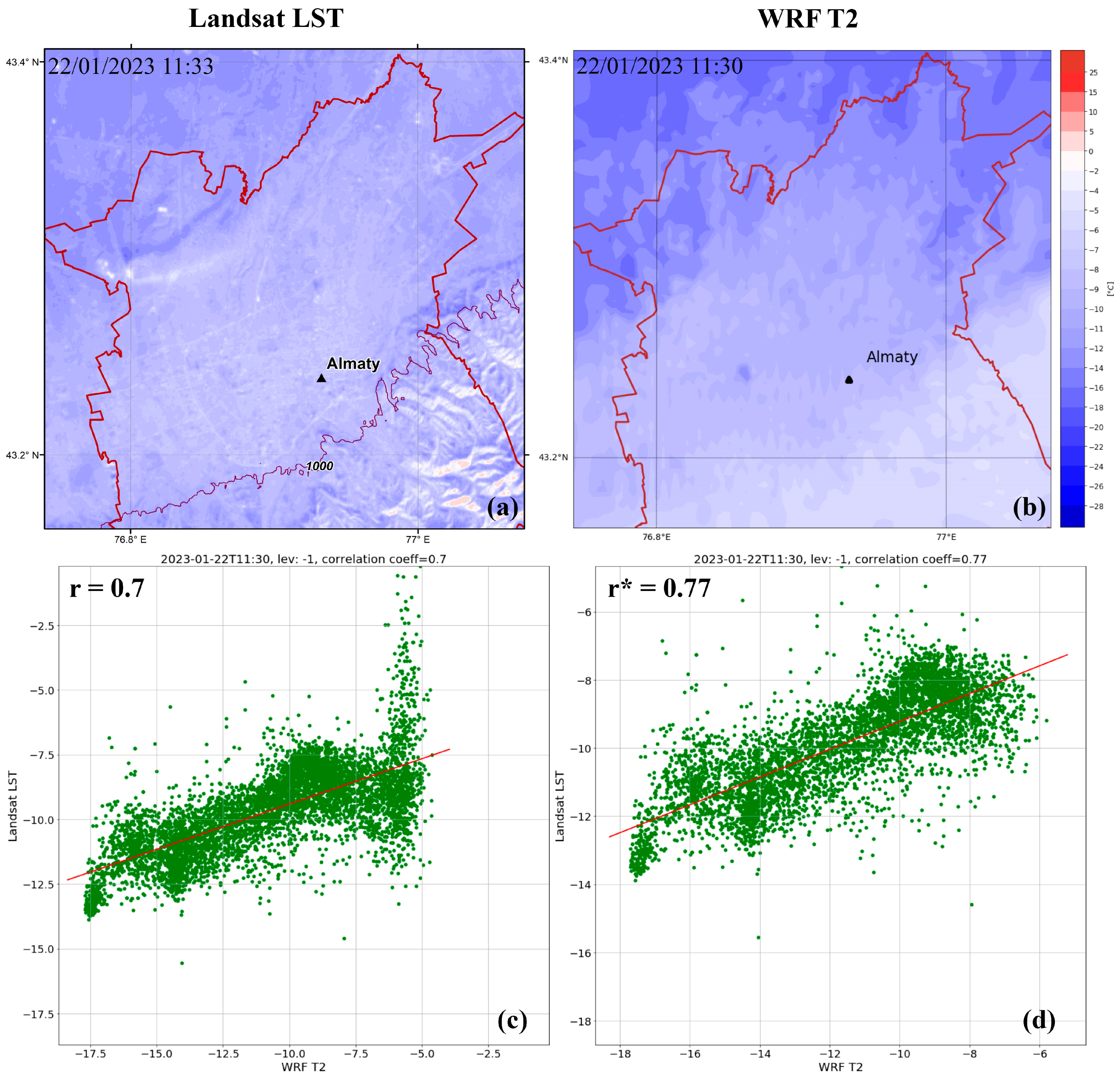
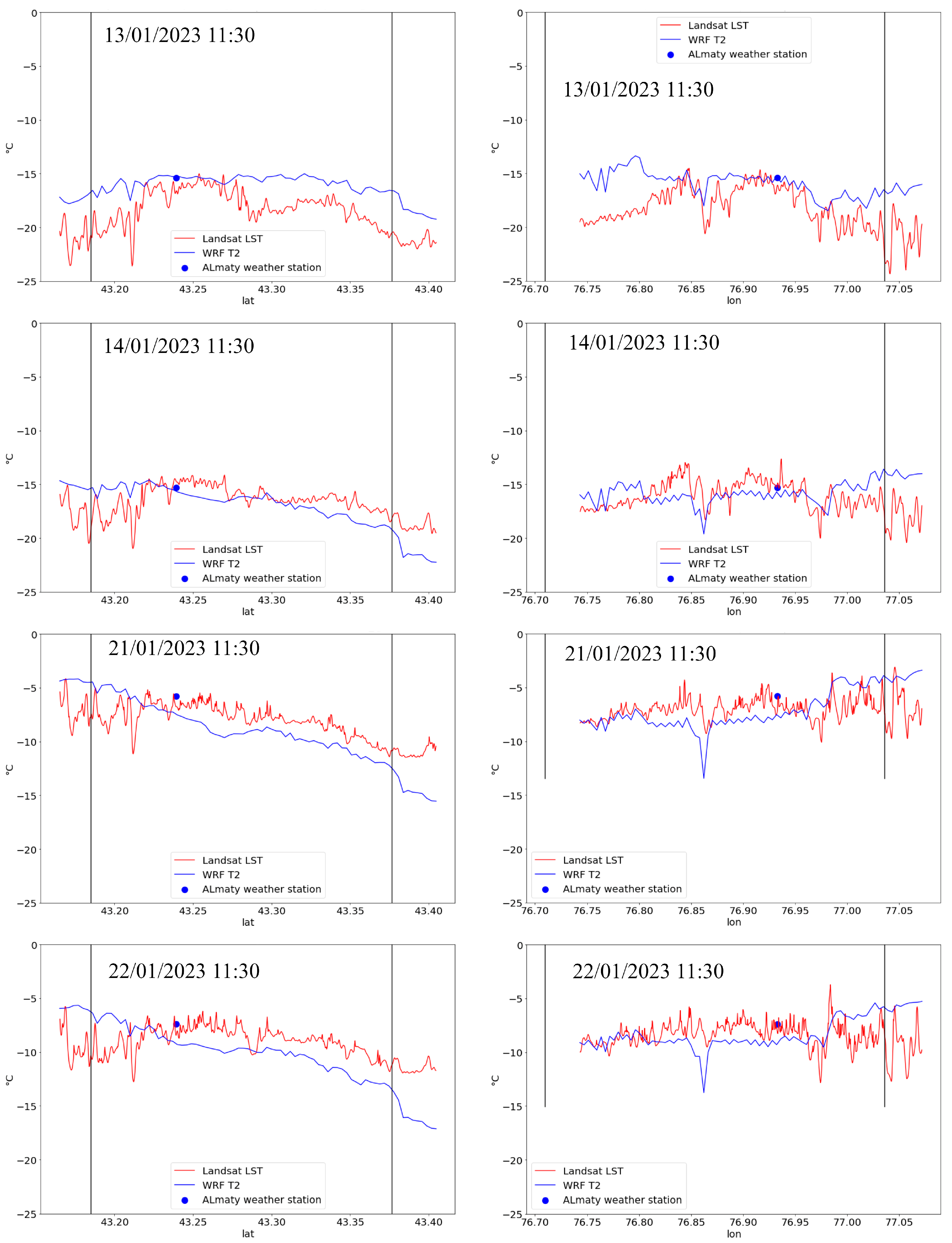
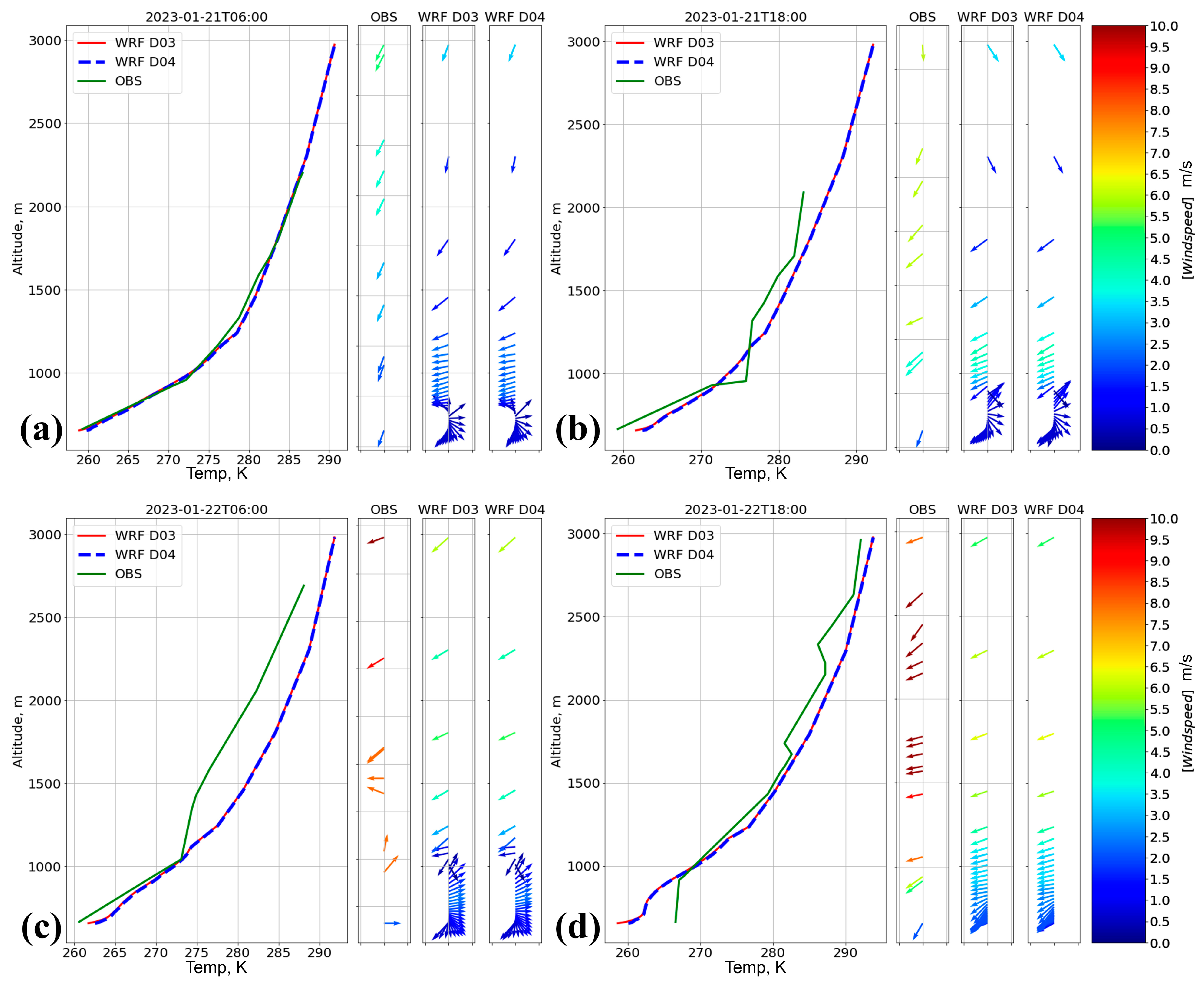
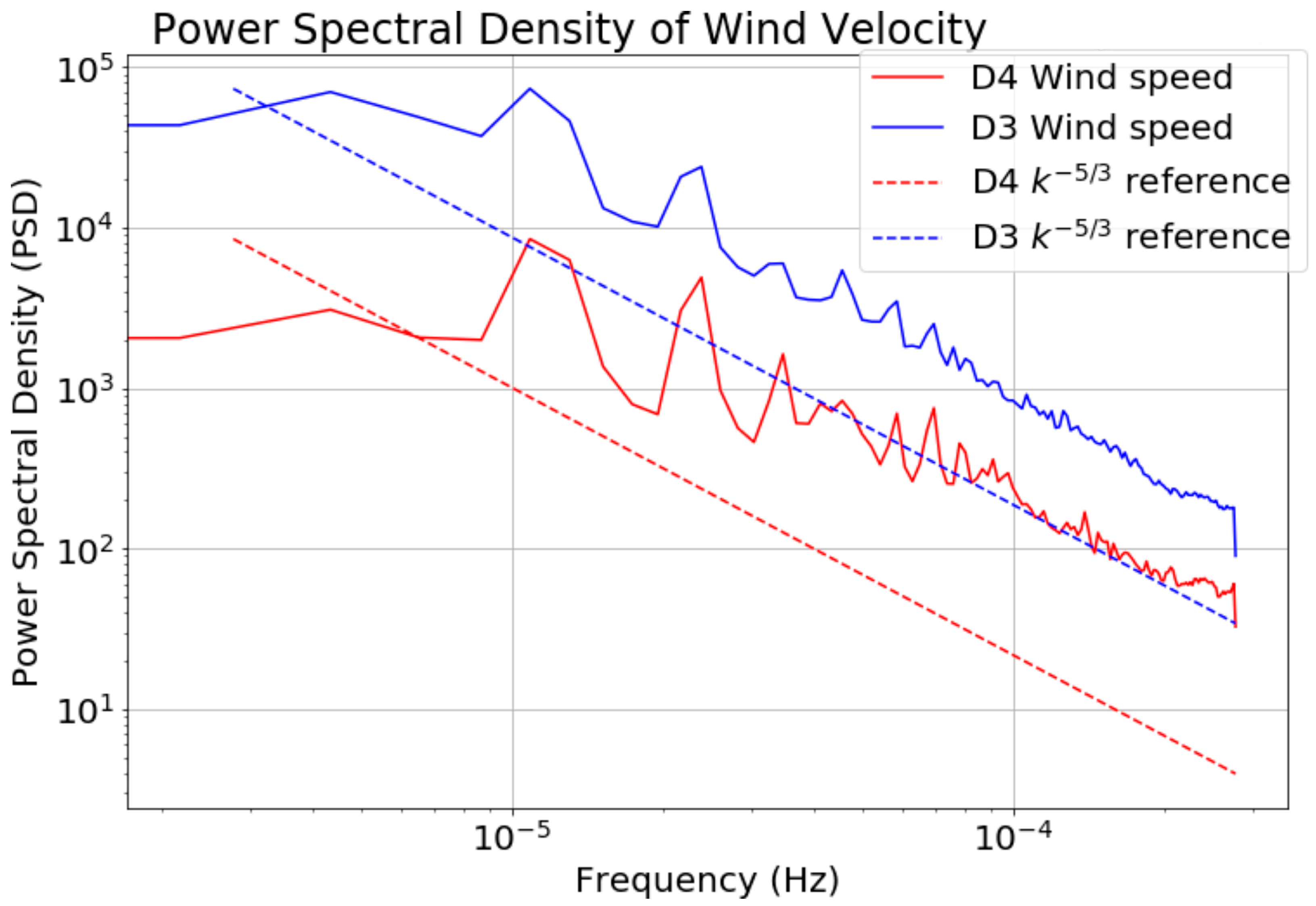
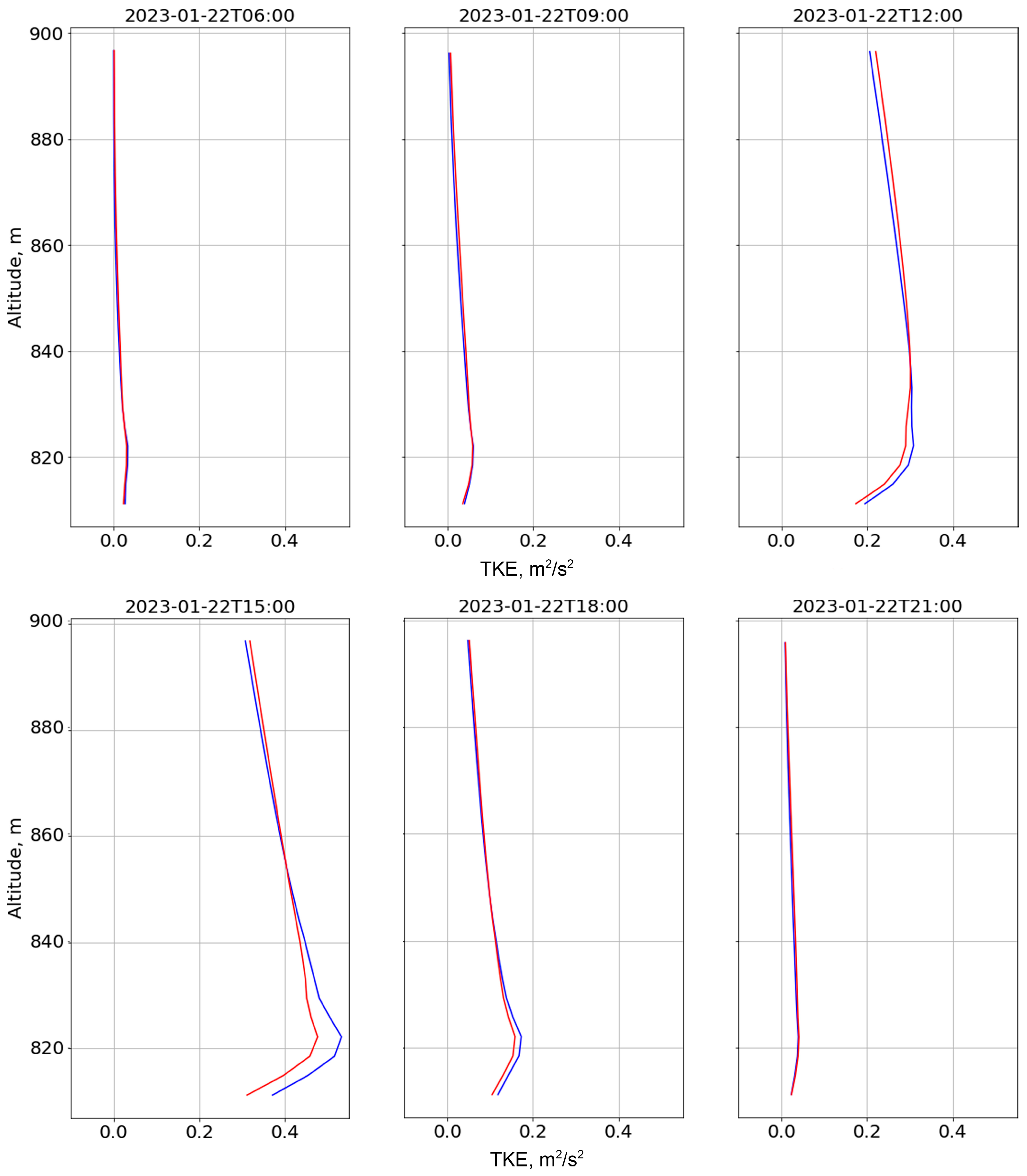

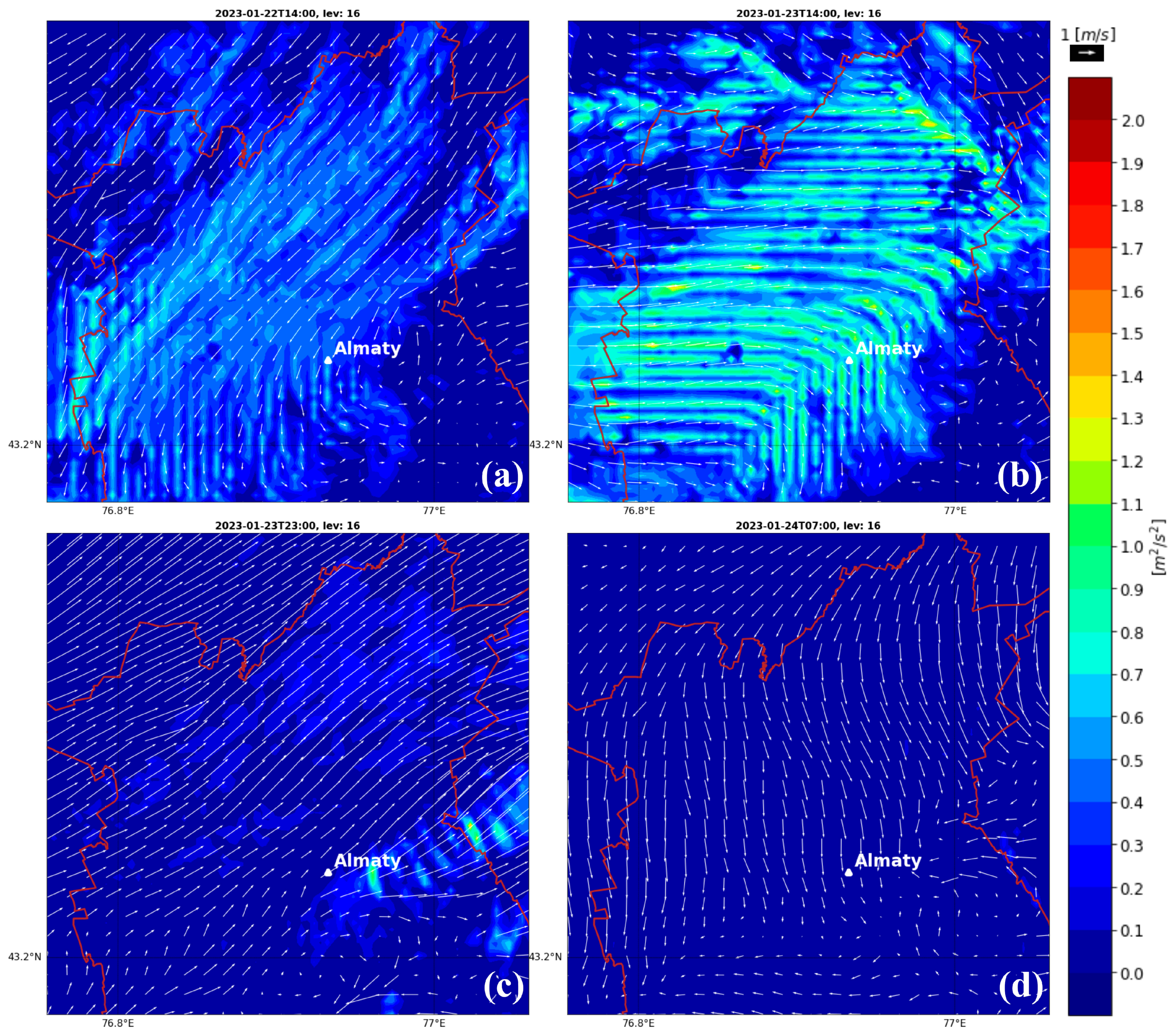
| Parameters/Experiments | WRF LCZ (WRF D3) | WRF D4 | WRF Urban3 |
|---|---|---|---|
| Domain grid cell size (km) | 1 | 0.333 | 1 |
| Initial and boundary conditions | D2 (two-way nested) | D3 (two-way nested) | D2 (two-way nested) |
| Simulated period | From 00:00 GMT 13 January 2023 to 00:00 GMT 23 January 2023 | ||
| Microphysics | WRF Single-Moment 6-Class Microphysics Scheme (WSM6) [40] | ||
| PBL Physics | Bougeault and Lacarrere parameterization (BouLac) [10] | ||
| Convection | Kain–Fritsch parameterization (KF) [41] | ||
| Radiation | Rapid Radiative Transfer Model for General circulation models (RRTMG) [42] | ||
| Turbulence | 2D Smagorinsky parameterization [1]. | ||
| Surface layer | Monin–Obukhov (Janjic) scheme (MO) [43] | ||
| Land/urban surface | Unified Noah land surface model [44]/BEP parameterization [11] | ||
| Land use | LCZ | LCZ | USGS +3 urban classes |
| Name | Lat | Lon | Source Height, m | Source Power, kg/h |
|---|---|---|---|---|
| CHP-2 | 43.29 | 76.797 | 129 | 3275.6 |
| CHP-3 | 43.42 | 77.01 | 60 | 1156.4 |
| Name | Coordinates | BIAS_T, °C | MAE_T, °C | RMSE_T, °C | BIAS_v, m/s | MAE_v, m/s | RMSE_v, m/s | |||||||
|---|---|---|---|---|---|---|---|---|---|---|---|---|---|---|
| Lat | Lon | LCZ | Urb3 | LCZ | Urb3 | LCZ | Urb3 | LCZ | Urb3 | LCZ | Urb3 | LCZ | Urb3 | |
| Almaty | 43.24 | 76.93 | −0.10 | −1.86 | 0.92 | 1.88 | 1.15 | 2.10 | 0.11 | 0.26 | 0.30 | 0.39 | 0.55 | 0.63 |
| Airport | 43.36 | 77.00 | −1.56 | −2.55 | 1.81 | 2.56 | 2.28 | 3.03 | −0.47 | −0.51 | 0.96 | 1.00 | 1.21 | 1.25 |
| Kamenskoe Plato | 43.18 | 76.97 | 0.03 | −0.50 | 0.93 | 0.94 | 1.18 | 1.22 | −0.63 | −0.05 | 0.76 | 0.64 | 1.01 | 0.85 |
| BAL | 43.06 | 76.98 | 0.79 | 0.85 | 1.57 | 1.59 | 1.99 | 2.03 | 0.24 | 0.45 | 1.09 | 0.83 | 1.45 | 1.08 |
| Iliysky | 43.48 | 76.96 | −1.08 | −2.78 | 1.81 | 2.81 | 2.41 | 3.11 | 0.15 | 0.81 | 0.50 | 1.26 | 0.77 | 1.52 |
| Aksengir | 43.50 | 76.27 | 0.34 | −0.13 | 1.91 | 1.51 | 2.35 | 1.92 | −0.24 | 0.39 | 0.67 | 1.05 | 0.97 | 1.36 |
| Mean | 0.65 | 1.44 | 1.49 | 1.88 | 1.89 | 2.24 | 0.31 | 0.41 | 0.71 | 0.86 | 0.99 | 1.12 | ||
| Name | Coordinates | BIAS_T, °C | MAE_T, °C | RMSE_T, °C | BIAS_v, m/s | MAE_v, m/s | RMSE_v, m/s | |||||||
|---|---|---|---|---|---|---|---|---|---|---|---|---|---|---|
| Lat | Lon | D3 | D4 | D3 | D4 | D3 | D4 | D3 | D4 | D3 | D4 | D3 | D4 | |
| Almaty | 43.24 | 76.93 | −0.10 | −0.03 | 0.92 | 0.92 | 1.15 | 1.12 | 0.11 | 0.07 | 0.30 | 0.26 | 0.55 | 0.51 |
| Airport | 43.36 | 77.00 | −1.56 | −0.41 | 1.81 | 1.31 | 2.28 | 1.70 | −0.47 | −0.61 | 0.96 | 1.01 | 1.21 | 1.26 |
| Kamenskoe Plato | 43.18 | 76.97 | 0.03 | 0.12 | 0.93 | 0.94 | 1.18 | 1.18 | −0.63 | −0.56 | 0.76 | 0.75 | 1.01 | 0.98 |
| Alm-007 | 43.28 | 76.87 | −1.03 | −1.42 | 1.15 | 1.48 | 1.44 | 1.75 | 0.50 | 0.43 | 0.60 | 0.53 | 0.70 | 0.65 |
| Alm-008 | 43.25 | 76.88 | −1.99 | −2.04 | 2.00 | 2.05 | 2.37 | 2.41 | 0.24 | 0.20 | 0.34 | 0.33 | 0.50 | 0.49 |
| Alm-010 | 43.24 | 76.83 | −1.77 | −1.69 | 1.80 | 1.73 | 2.06 | 2.00 | 0.41 | 0.40 | 0.44 | 0.42 | 0.63 | 0.61 |
| Mean | 1.08 | 0.95 | 1.44 | 1.40 | 1.75 | 1.70 | 0.39 | 0.38 | 0.57 | 0.55 | 0.77 | 0.75 | ||
| Name | Lat | Lon | LCZ | LCZ_D3 | LCZ_D4 |
|---|---|---|---|---|---|
| Almaty | 43.24 | 76.93 | LCZ 5 | LCZ 5 | LCZ 5 |
| Airport | 43.36 | 77.00 | LCZ 6 | LCZ 10 | LCZ C |
| Kamenskoe Plato | 43.18 | 76.97 | LCZ 9 | LCZ A | LCZ 9 |
| Alm-007 | 43.28 | 76.87 | LCZ 10 | LCZ A | LCZ 7 |
| Alm-008 | 43.25 | 76.88 | LCZ 5 | LCZ 5 | LCZ 5 |
| Alm-010 | 43.24 | 76.83 | LCZ 5 | LCZ 5 | LCZ 5 |
Disclaimer/Publisher’s Note: The statements, opinions and data contained in all publications are solely those of the individual author(s) and contributor(s) and not of MDPI and/or the editor(s). MDPI and/or the editor(s) disclaim responsibility for any injury to people or property resulting from any ideas, methods, instructions or products referred to in the content. |
© 2024 by the authors. Licensee MDPI, Basel, Switzerland. This article is an open access article distributed under the terms and conditions of the Creative Commons Attribution (CC BY) license (https://creativecommons.org/licenses/by/4.0/).
Share and Cite
Dedova, T.; Balakay, L.; Zakarin, E.; Bostanbekov, K.; Abdimanap, G. High-Resolution WRF Modeling of Wind and Thermal Regimes with LCZ in Almaty, Kazakhstan. Atmosphere 2024, 15, 966. https://doi.org/10.3390/atmos15080966
Dedova T, Balakay L, Zakarin E, Bostanbekov K, Abdimanap G. High-Resolution WRF Modeling of Wind and Thermal Regimes with LCZ in Almaty, Kazakhstan. Atmosphere. 2024; 15(8):966. https://doi.org/10.3390/atmos15080966
Chicago/Turabian StyleDedova, Tatyana, Larissa Balakay, Edige Zakarin, Kairat Bostanbekov, and Galymzhan Abdimanap. 2024. "High-Resolution WRF Modeling of Wind and Thermal Regimes with LCZ in Almaty, Kazakhstan" Atmosphere 15, no. 8: 966. https://doi.org/10.3390/atmos15080966







